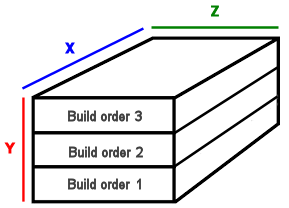Specifying the build order of split 3D objects
You can assign a numeric build order to 3D objects in a 3D model that have been created as a result of splitting one object into multiple objects. If you assign a build order to split 3D objects, it is used to determine the order in which split 3D objects appear during timeline simulations in cases where more than one object is assigned to a single task. You can also use the build order as a criterion when creating IFC product searches, to specify which 3D objects should be included in an IFC product search. You can view the build order of 3D objects in the IFC Properties pane; note that the build order of non-split 3D objects defaults to 0.
You can specify that a build order should be assigned automatically to each of the 3D objects that are created when you split an object, by selecting the Set build order on split products check box and entering a starting number on either the Split Product or the Split Product Manually dialog - depending on the way in which you are splitting the object. If you do this, Asta Powerproject 4D assigns a numeric build order to each of the 3D objects that are created by the split in as logical a way as possible.
For example, if you were to split a 3D object into three separate objects with two cuts along its Y axis and specified that you wanted a build order to be assigned to each of the resulting objects, starting at 1, the build orders might be assigned as illustrated below:

It is always worth checking the way in which the build orders have been assigned after you have split a 3D object, as in some cases the automatically assigned build orders may not match the order in which tasks will be carried out in a project. For example, rather than the build orders being assigned as illustrated above, they might be assigned as illustrated below:

As the lowest of the 3D objects is likely to be the first one to be built and the highest is likely to be the last, in this case the automatically assigned build orders do not match the order in which the tasks will be carried out. If this is the case, you can recombine the split 3D objects (by right-clicking one of the objects that resulted from the split and selecting Split/Merge Products - Remove Split from the menu that appears) then carry out the split again, this time selecting the Reverse build order assignment check box on either the Split Product or the Split Product Manually dialog - depending on the way in which you split the object in the first place. Selecting this check box reverses the order in which the build orders are assigned.
You can also edit the build orders of the split 3D objects manually. To do this:
- Select the 3D object or objects to which you want to assign different build orders. If you are revising the build orders of more than one 3D object at the same time, the order in which you select the objects is important: select them in the order in which you want build orders to be assigned to the objects.
- Right-click one of the selected 3D objects and select Set Product Build Orders from the menu that appears. The Set Product Build Orders dialog appears.
- To assign the same build order to all of the selected 3D objects, click the Identical build orders equal to radio button and enter the appropriate build order in the field on the dialog; to assign sequential build orders to the selected objects in the order in which they were selected, click the Sequential build orders from radio button and enter the first build order to assign in the field on the dialog.
- Click OK.
If you want to edit the build orders of all of the 3D objects that were created as a result of a split, you can identify the objects easily by right-clicking one of them and selecting Split/Merge Products - Select Related Products from the menu that appears. All of the 3D objects that were created as a result of that particular split are selected in the IFC Model pane.
Splitting 3D objects in a 3D model
Recombining previously-split 3D objects in a 3D model
Copying split and merge data to a different revision of a 3D model